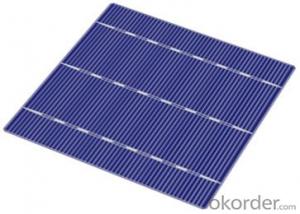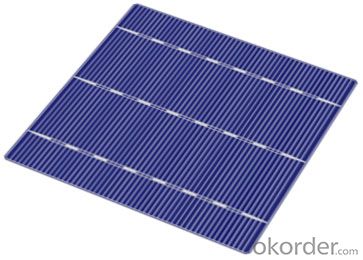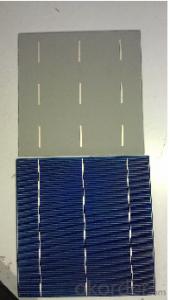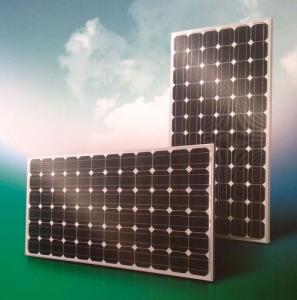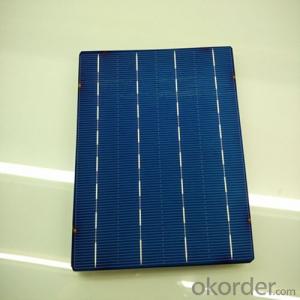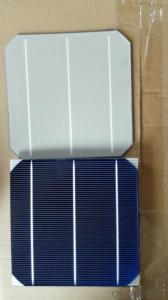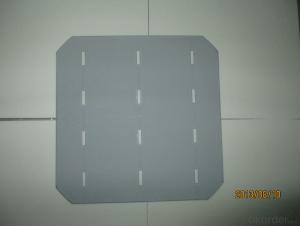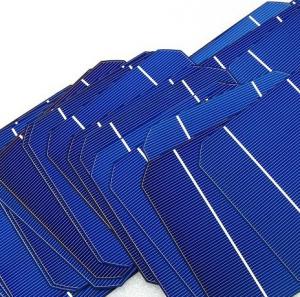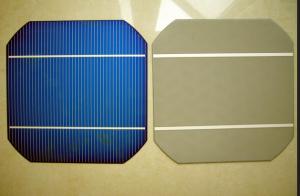Maxeon Solar Cells Poly 156x156mm with High Conversion Efficiencies
- Loading Port:
- Tianjin
- Payment Terms:
- TT or LC
- Min Order Qty:
- 10 watt
- Supply Capability:
- 10000 watt/month
OKorder Service Pledge
OKorder Financial Service
You Might Also Like
our cells special features:
1. High conversion efficiencies resulting in superior power output performance
2.Outstanding power output even in low light or high temperature conditions
3.Optimized design for ease of soldering and lamination
4.Long-term stability,reliability and performance
5.For 156P poly cells with high efficiency in photovoltaic conversion 16.3%-17.5%.
6.Low inverse current, high shunt resistance and high dependability.
7. Our poly cells efficiency include: 17%-18%.
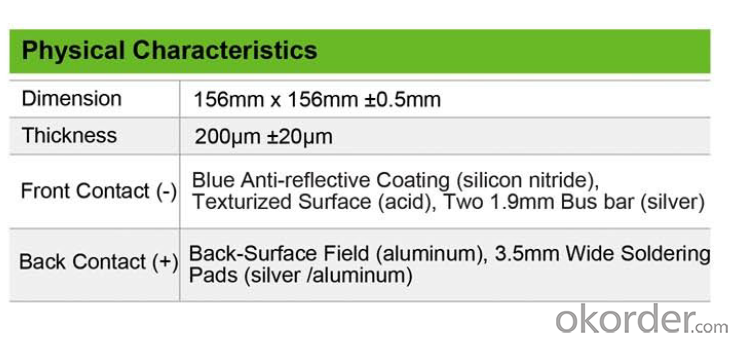
Conversion of different solar materials
Solar photovoltaic power generation more important seats in the world's energy consumption in the near future, not only to replace part of conventional energy, are more likely to become the main body of the world's energy supply.
Solar cell is a light energy into electrical energy components. Low-cost high-efficiency solar cell photovoltaic technology long chase the target, it is hard to compete for each enterprise technology territory.
Solar cells market applications more wide-ranging and diversified to meet the various needs of photovoltaic products are constantly available, in addition to large-scale grid-connected PV power plant outside, combined with the construction of photovoltaic systems, small-scale PV systems, off-grid PV systems, also fast rise. The cost of solar cells and photovoltaic systems continued to decline and approximate cost of conventional power generation, is still the subject of photovoltaic industry development, and solar cells will continue to walk in high-efficiency, low-cost way.
We are familiar with crystalline silicon cells into single crystal and polycrystalline, except that the silicon wafers. Monocrystalline wafers made of polysilicon raw material crystal pullers pull into a bar and then sliced into monocrystalline, polycrystalline silicon film is made of polysilicon through ingot casting furnaces made of polysilicon ingots and then sliced. However, polycrystalline silicon photovoltaic cells still dominant the market currently.
The basic structure of a solar cell is to use a P-type and N-type semiconductors are joined together. The most important parameter is the photoelectric conversion efficiency. In the single-crystal battery, the current level of industrialization of developed N-type monocrystalline cells in about 21% -24%, the level of domestic industry P-type monocrystalline cells is about 18.7% -19.2%, 19.2% in overseas -20% or so. Polycrystalline battery’s industrialization level is the 17% - 17.5%. Here are edited from the N-type monocrystalline cells, P-type monocrystalline cells, polycrystalline cells are three types of contrast, certified technological frontier representatives listed below.
- Q: Can solar cells be used on vehicles?
- Yes, solar cells can be used on vehicles. They can be integrated into the design of vehicles to harness solar energy and convert it into electricity to power various components such as lights, air conditioning systems, and even electric motors in hybrid or electric vehicles. This helps reduce reliance on fossil fuels and makes vehicles more sustainable and environmentally friendly.
- Q: How do solar cells handle high winds or hurricanes?
- Solar cells are designed to withstand high winds or hurricanes by being securely mounted to structures or rooftops. Additionally, they are built to be durable and have undergone rigorous testing to ensure that they can withstand extreme weather conditions.
- Q: How to make solar cells in a scientific way?
- Follow the scientific instructions, then you will learn how to make it.
- Q: Can solar cells generate power at night?
- No, solar cells cannot generate power at night as they rely on sunlight to produce electricity.
- Q: Can solar cells be used to power remote transportation systems?
- Yes, solar cells can be used to power remote transportation systems. Solar cells convert sunlight into electricity, which can be stored in batteries and used to power vehicles, such as electric cars, bikes, boats, or even small aircraft. This makes solar energy an environmentally friendly and sustainable option for powering transportation in remote areas where access to conventional power sources may be limited or non-existent.
- Q: How do solar cells perform in areas with high levels of air pollution and dust?
- Solar cells perform less efficiently in areas with high levels of air pollution and dust. The particles in the air can block sunlight from reaching the solar cells, reducing their ability to convert sunlight into electricity. This can result in a decrease in overall energy production and efficiency of the solar panels. Regular cleaning and maintenance of the solar cells can help mitigate the negative impact of air pollution and dust on their performance.
- Q: Can solar cells be used in public charging stations for electric vehicles?
- Yes, solar cells can be used in public charging stations for electric vehicles. By harnessing solar energy, these charging stations can provide clean and renewable power to charge electric vehicles, reducing reliance on traditional grid electricity and contributing to a more sustainable transportation system.
- Q: Can solar cells be used for water heating applications?
- Yes, solar cells can be used for water heating applications. Solar thermal collectors, which incorporate solar cells, can absorb sunlight and convert it into heat energy, which can be used to heat water for various purposes such as domestic hot water, swimming pools, and space heating.
- Q: Can solar cells be used in marine applications?
- Yes, solar cells can be used in marine applications. They can be integrated into boats, yachts, and other marine vessels to generate electricity from sunlight, which can be used to power various onboard systems and equipment. Additionally, solar cells can also be used to charge batteries, providing a reliable and sustainable source of energy for marine applications.
- Q: Which brand of the solar cells is sold with the lower price on the market? Which brand is more practical for the countryside?
- The low price solar cells do not always mean lower quality, because sometime the government may provide the tax refund to support saving the energy.
Send your message to us
Maxeon Solar Cells Poly 156x156mm with High Conversion Efficiencies
- Loading Port:
- Tianjin
- Payment Terms:
- TT or LC
- Min Order Qty:
- 10 watt
- Supply Capability:
- 10000 watt/month
OKorder Service Pledge
OKorder Financial Service
Similar products
Hot products
Hot Searches
Related keywords
